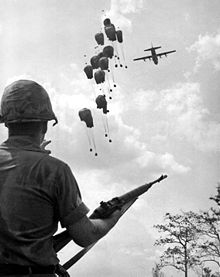| 1967 in the Vietnam War | |||
|---|---|---|---|
← 1966 1968 → | |||
 Air drop of supplies in Operation Junction City | |||
| |||
| Belligerents | |||
|
Anti-Communist forces: |
Communist forces: | ||
| Strength | |||
|
South Vietnam: 798,800 |
US estimate: 242,000–600,000 | ||
| Casualties and losses | |||
|
US: 11,363 killed[1] South Vietnam: 12,716 killed[2]: 275 Allies: Unknown | US estimate: 140,000 casualties[3] | ||
At the beginning of 1967 the United States was engaged in a steadily expanding air and ground war in Southeast Asia. Since its inception in February 1965, Operation Rolling Thunder, the bombing campaign against North Vietnam, had escalated in the number and significance of its targets, inflicting major damage on transportation networks industry, and petroleum refining and storage facilities. Yet the campaign showed no signs of achieving either of its stated objectives. The air attacks had not broken the Hanoi government's will to continue the war, and they had not halted or appreciably hindered the flow of People's Army of Vietnam (PAVN) troops and supplies into South Vietnam. North Vietnam had been able to repair damage and develop substitutes for destroyed facilities rapidly enough to counter the incremental escalation of the U.S. air campaign. With Soviet and Chinese assistance, the North Vietnamese had built a large and sophisticated air defense system. Its guns and missiles extracted a toll in pilots and aircraft for every American raid. On the ground in South Vietnam, the U.S. force buildup, begun in late 1965, was approaching completion. More than 380,000 American troops were in the country, alongside over 730,000 Army of the Republic of Vietnam (ARVN) soldiers and some 52,000 soldiers from other allied nations. After a year of base building and intensifying combat, the U.S. commander, General William Westmoreland, believed that his forces were ready for major offensives that would seize the battlefield initiative from the PAVN and Viet Cong (VC). The PAVN/VC, however, had been conducting their own buildup, including the infiltration into South Vietnam of regular PAVN divisions. These units, along with VC guerrillas and light infantry formations, were countering the American challenge. Within South Vietnam, the PAVN/VC sought opportunities to inflict American casualties in large and small engagements. They also concentrated troops at various points on South Vietnam's borders to create a strategic threat to the allies and compel the Military Assistance Command, Vietnam, (MACV) to disperse its reserves.[4]
- ^ "Vietnam War U.S. Military Fatal Casualty Statistics". National Archives. 15 August 2016. Retrieved 10 October 2021.
- ^ Clarke, Jeffrey (1988). United States Army in Vietnam: Advice and Support: The Final Years, 1965-1973. Center of Military History, United States Army. ISBN 978-1518612619.
 This article incorporates text from this source, which is in the public domain.
This article incorporates text from this source, which is in the public domain.
- ^ Art, Robert; Waltz, Kenneth (2004). The Use of Force: Military Power and International Politics. Rowman & Littlefield. p. 241. ISBN 9780742525573.
- ^ Cosmas, Graham (2009). The Joint Chiefs of Staff and the War in Vietnam, 1960-1968 Part 3 (PDF). Office of Joint History Office of the Chairman of the Joint Chiefs of Staff. p. 1. ISBN 978-1482378696.
 This article incorporates text from this source, which is in the public domain.
This article incorporates text from this source, which is in the public domain.
© MMXXIII Rich X Search. We shall prevail. All rights reserved. Rich X Search
